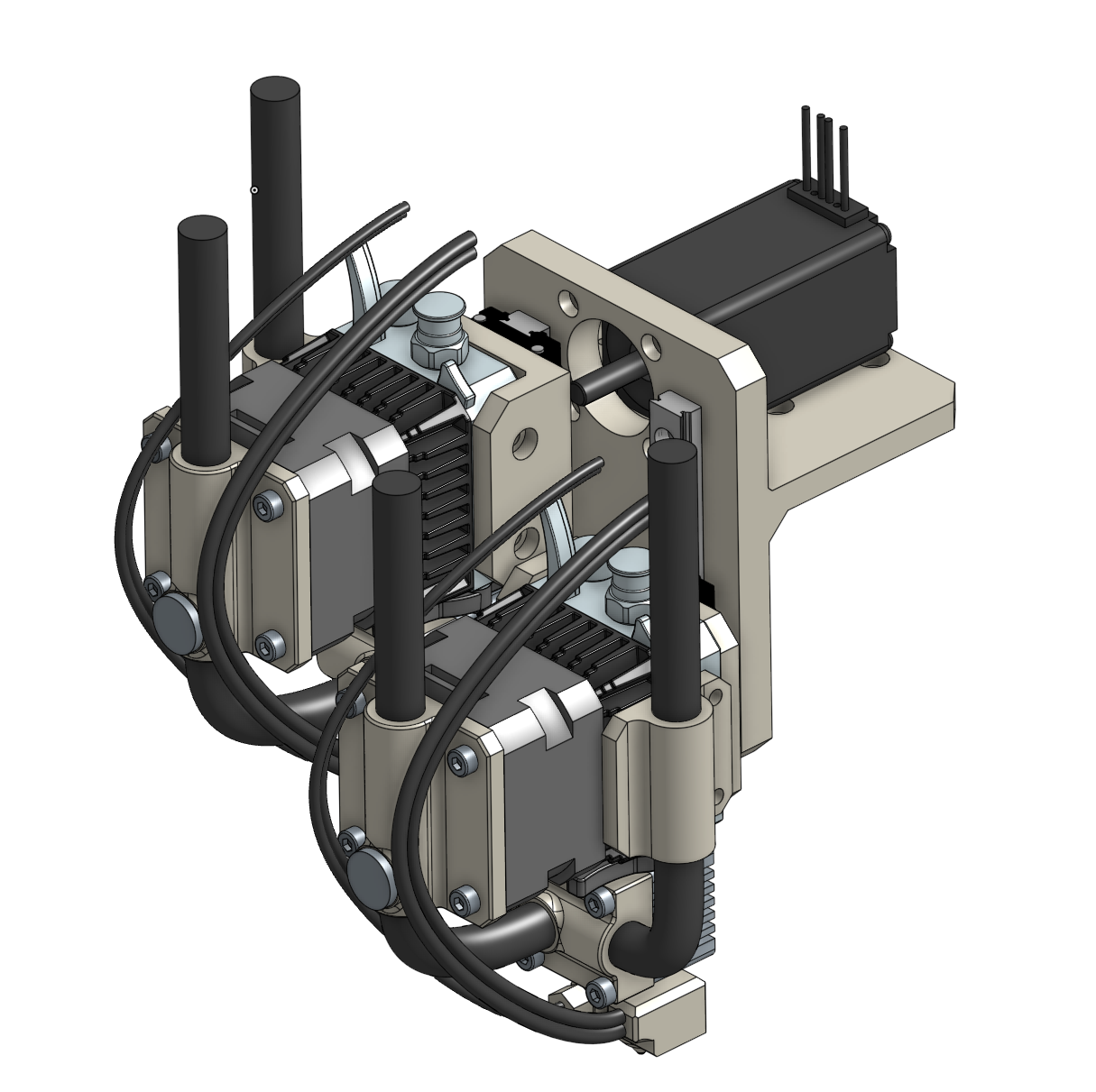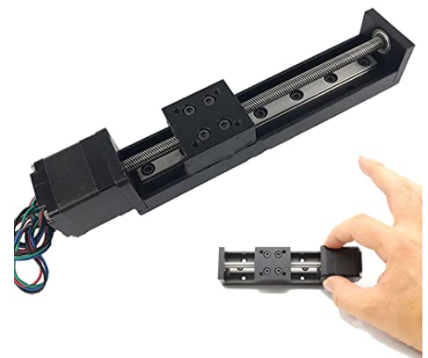Which frame design can scale best?
-
-
@mikeabuilder I would love to be able to source steel easily, but here in switzerland I couldn't find a reasonably priced service that does precision steel cutting.
-
@fcwilt If I do not use the "crossed gantry" (ala ultimaker), I could also use an IDEX arrangement instead of one large head, but this would mean 2 moving steppers along Y. I need dual head, but not necessarily dual carriage.
I am still "tinkering around" but I thought of maybe using a small stepper with a rack gear to be able to lift either extruder. The following picture is just the placement, rack gear or mini belt is not present yet. Basically for probing both extruders would be in the middle position, and for printing either one would be down.

The advantage of moving one large head is that I could mount anything (pellet...) and for a large printer, it is a plus.
I love the mark forged kinematic idea, but it makes one belt very long, that's not an issue for a large printer?
-
@kuon said in Which frame design can scale best?:
I love the mark forged kinematic idea, but it makes one belt very long, that's not an issue for a large printer?
You mean the X belt?
At the time I was deciding between a CoreXY and the Mark Forged. Everyone seemed to be doing a CoreXY so I decided to be difficult - I mean different.
I never considered the X belt to be that long. I did opt for 9mm belts instead of 6.
Frederick
-
@kuon said in Which frame design can scale best?:
I am still "tinkering around" but I thought of maybe using a small stepper with a rack gear to be able to lift either extruder. The following picture is just the placement, rack gear or mini belt is not present yet. Basically for probing both extruders would be in the middle position, and for printing either one would be down.

What are those largish black rods for?
I used one these in 50mm for a recent project:

-
@fcwilt Yeah, for my frame size it is nearly a 6 meter belt. That's why I am considering a regular cartesian printer (like the craftbot flow serie), and thus maybe IDEA. At first I thought the ultimaker crossed gantry would be cool, as it allows for short belt (I would have used 4 steppers, 2 per axles).
-
@fcwilt Black rods are water cooling pipes for "illustration".
-
@kuon said in Which frame design can scale best?:
@fcwilt Yeah, for my frame size it is nearly a 6 meter belt. That's why I am considering a regular cartesian printer (like the craftbot flow serie), and thus maybe IDEA. At first I thought the ultimaker crossed gantry would be cool, as it allows for short belt (I would have used 4 steppers, 2 per axles).
The original cross-gantry setup was rather elegant in that it used two round rounds, as both guides and support, for the crossed part. That only works for small printers. For your size you would need to use linear rails mounted to something like a metal plate or extrusion to prevent gantry zag.
The cross-gantry I experimented with used 4 steppers which worked very well - smooth, quiet and very fast.
I'm a fan of the design and may well finished building the printer after I finish the one I am working on now.
Frederick
-
@fcwilt What I like with the cross gantry is that I can have stationary steppers and short belts (with 4 steppers). Of course I would use a heavy "X" with profiles with linear rails on them instead of rods.
-
Then you should go with cross gantry.
The short belts are a plus.
And as long as you don't mind the extra mass of the cross I believe you would be happy with the result.
To keep down moving mass on my printers they are all equipped with Zesty Nimbles as you can see in the image I posted.
Frederick
-
@fcwilt Well, with the cross I can put steppers as big as I want as I will not move them. As for non direct drive, I want to keep the option open for a pellet extruder which weight roughly the same as my dual extruder head pictured above.
-
@kuon said in Which frame design can scale best?:
@fcwilt Well, with the cross I can put steppers as big as I want as I will not move them. As for non direct drive, I want to keep the option open for a pellet extruder which weight roughly the same as my dual extruder head pictured above.
Pellet Extruder???
Frederick
-
-
@fcwilt Yeah, like this https://dyzedesign.com/pulsar-pellet-extruder/ I want this printer to be a platform were I can experiment. And I want my gantry to be able to handle this weight (even if I would print slowly with that).
Of course that extruder is overkill (and expensive), but there are some other high flow (also 2.85mm filament based, like this https://dyzedesign.com/typhoon-extruder/ ) extruders which weight like 2kg I might try.
Even if I do not plan on using it now, while building a project that large, I'd like to have a gantry that is able to handle other "heads".
-
Wow. You could do amazing things with that beast.
Yes you want to come up with a good design for allowing changing tools - hopefully without a lot of work.
Fun project.
Frederick
-
@fcwilt said in Which frame design can scale best?:
@kuon
Wow. You could do amazing things with that beast.
Yes you want to come up with a good design for allowing changing tools - hopefully without a lot of work.Instead of linear rails for the extruder -mini Z axes, you could use dovetail profiles. They could easily slide out for maintenance or tool changing.
For a light load, I made my own PTFE sliders. -
Late replay, but @fcwilt, I am presently planning to use a single Z stepper. Mostly a limitation I've imposed on myself trying to stick with only the Duet3 and having enough drivers for a multi-extruder head. I'm planning some custom code during bed.g to measure some bed heights and tell me how much to adjust each of the front Kinematic balls under the bed.
And regarding belt length, I think any arrangement that keeps both X and Y motors stationary will necessarily require at least one belt that is essentially a square that encloses the print area. Both CoreXY and MarkForged have this characteristic.
Also, regarding belt stretch when comparing the MarkForges and a CoreXY, if you look at the MF picture in this thread, the largest forces on the either belt will be on accelerations and decelerations in the Y direction (you are trying to speed up or slow down the gantry and also the extruder on Y moves). The belt stretch should be less because the belt is shorter (approx half as long) than a CoreXY. However, in a CoreXY, you have two belts managing the same force, so the force on each belt is half, resulting in approximately the same amount of stretch.
Regarding this whole topic, the thing that I think would be interesting is not so much "which is best", but "what are the tradeoffs". Each designer needs to make tradeoffs between many things to make a design that is right for their application. @kuon can't easily source laser cut steel they are, so that affects their decisions. I hate going into the machine shop, so that affects mine. Someone designing for high volume production will make different decisions. And a lot of the effects of our design decisions show up much later, and in things we didn't really think about at design time. So understanding the tradeoffs is valuable.
-
@mikeabuilder I agree with what you said about tradeof. About belt length, I considered cross gantry because it has short belt and no moving steppers. I think it is the only arrangement that has those two qualities. I will try a real design with a cross gantry and see how it goes.
-
On the subject of belt stretch, as I am often at pains to point out, do the maths. People get exited when they read something on the internet and see that applying a force of (say) 40 lbs) using a tensile test machine, gives elongation of about 0.6%. (That's just an example I found on the internet - it's not to be taken as fact). Look at data sheets if you can find them.
But if you take the mass that you are going to move and multiply it by the acceleration, you'll find that the force that you are going to apply is so low that belt stretch is likely to be insignificant.
By way of an example, I have what is considered to be a very heavy hot end because it has 6 inputs. Because of that I use a pair of parallel X rails which adds even more weight. The total moving mass in the Y direction is about 2 Kgs. I accelerate this at around 1000 mm/sec^2 which means that I'm applying a force of around 2 Newtons or around 200 gms or about 0.4lb to the belts. If the internet example is anything to go by (which I doubt) then that would mean I'd be looking at belt stretch of around 0.006%. But because this is CoreXY machine with two belts, then we can halve that again giving around 0.003%. And of course, that stretch will only apply to the section of belt between the attachment point on the carriage and the drive motor pulley. In my case, that's around 1.2 metres maximum giving about 0.036mm worse case. That's why I'm perfectly happy with my long, 6mm wide belts, despite the relatively high mass that I'm throwing around.
Of course (and before someone leaps in to point it out) using a higher acceleration and/or mass will lead to a higher force but my point is simply just do the maths for your own situation before getting to exited about belt stretch. -
This post is deleted!
